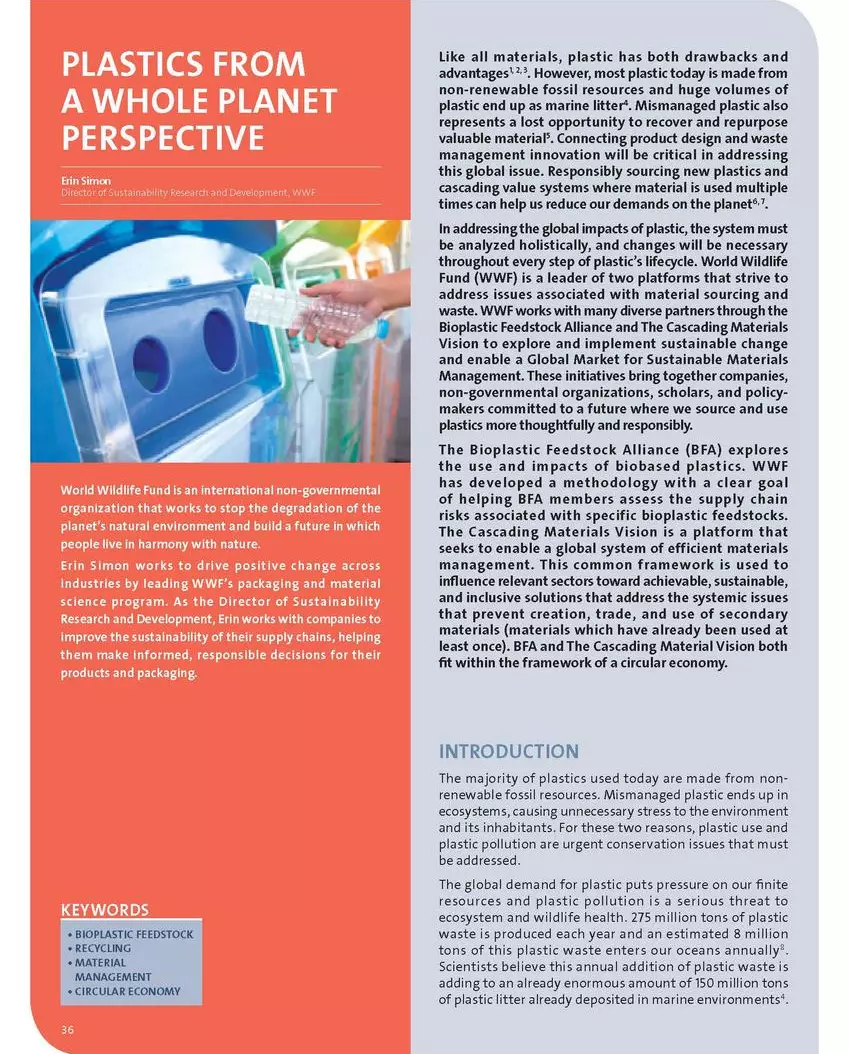Par Erin Simon
Director of Sustainability Research and Development, WWF
Like all materials, plastic has both drawbacks and advantages1, 2, 3. However, most plastic today is made from non-renewable fossil resources and huge volumes of plastic end up as marine litter4. Mismanaged plastic also represents a lost opportunity to recover and repurpose valuable material5. Connecting product design and waste management innovation will be critical in addressing this global issue. Responsibly sourcing new plastics and cascading value systems where material is used multiple times can help us reduce our demands on the planet6, 7.
In addressing the global impacts of plastic, the system must be analyzed holistically, and changes will be necessary throughout every step of plastic’s lifecycle. World Wildlife Fund (WWF) is a leader of two platforms that strive to address issues associated with material sourcing and waste. WWF works with many diverse partners through the Bioplastic Feedstock Alliance and The Cascading Materials Vision to explore and implement sustainable change and enable a Global Market for Sustainable Materials Management. These initiatives bring together companies, non-governmental organizations, scholars, and policymakers committed to a future where we source and use plastics more thoughtfully and responsibly.
The Bioplastic Feedstock Alliance (BFA) explores the use and impacts of biobased plastics. WWF has developed a methodology with a clear goal of helping BFA members assess the supply chain risks associated with specific bioplastic feedstocks. The Cascading Materials Vision is a platform that seeks to enable a global system of efficient materials management. This common framework is used to infl uence relevant sectors toward achievable, sustainable, and inclusive solutions that address the systemic issues that prevent creation, trade, and use of secondary materials (materials which have already been used at least once). BFA and The Cascading Material Vision both fit within the framework of a circular economy.
---
1. “The New Plastics Economy: Rethinking the future of plastics,” Ellen MacArthur Foundation.
2. P. Roy et al., “A review of life cycle assessment (LCA) on some food products,” J. Food Eng., vol. 90, no. 1, pp. 1–10, Jan. 2009.
3. K. Marsh and B. Bugusu, “Food Packaging— Roles, Materials, and Environmental Issues,” J. Food Sci., vol. 72, no. 3, pp. R39–R55, Apr. 2007.
4. “Plastics in the Ocean.” 2017. Ocean Conservancy. March 7, 2017.
5. “Cascading Materials: Extending the life of our natural resources | Projects | WWF,” World Wildlife Fund. [Online].
6. “A European Strategy for Plastics in a Circular Economy,” European Commission, Jan. 2018.
7. A. Grabowski, “Responsible Bioplastics,” p. 10, Nov. 2015.



